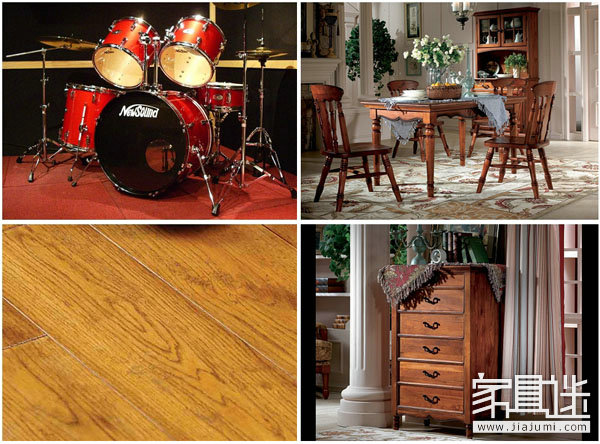Birch has been renowned since ancient times, admired for its elegant natural grain that captivated the ancients. Historically, birch bark was often used as a scabbard or sheath to carry weapons. Due to the homophonic relationship between "birch" and "hua" (flower), and the symbolic meaning of the wood, some believed that using birch represented nobility and righteousness. In short, birch has long been valued for its beauty and cultural significance.
The annual rings of birch are slightly visible, with straight grain and a fine, soft texture. The wood is flexible and easy to process, offering a smooth cutting surface and good paint and glue adhesion. It is considered a medium-grade wood, commonly used in solid wood and veneer applications. Originating from Northeast China, it features a fine, pale yellowish tone, with roots and knots forming intricate patterns. Its attractive grain made it popular for carving and decorative elements, such as door cores, while its bark was also appreciated for its flexibility and aesthetic appeal, often used in inlays on scabbards and bows.
In today's furniture market, birch is mainly sourced from the Southwest region. It comes in various styles, including Chinese, Southeast Asian, Japanese, Korean, and especially European, particularly French classical designs. Historically, French furniture—especially court and rustic styles—often used cherry wood, which was favored for its beauty and popularity in Europe. Unfortunately, the grain of Southwest birch closely resembles that of cherry, leading some unscrupulous sellers to mislabel it, causing confusion and unfairly tarnishing birch's reputation.

**Southwestern Birch**
**Distribution of Southwestern Birch:**
Southwestern birch is primarily found in Southwest China, southern, southeastern, and western Guangxi, as well as parts of Guizhou. These regions are geographically close to Vietnam, Laos, and Myanmar, making them part of the central distribution area of birch. The horizontal range spans approximately 97°3′ to 108°E, 19° to 25°N, and it grows at altitudes between 200 and 2800 meters.
**Color and Texture:**
Southwestern birch ranges in color from light red to deep red. The grain is straight, with a low luster and occasional staining. While the "V" pattern is rare, the wood exhibits fine structure, with wave-like patterns, swirling textures, tree knots, and bird-eye patterns on different cuts. However, it lacks dark streaks.
**Properties of Birch Wood:**
1. Birch wood has a fine structure, good strength, and an attractive color with a slight shine. It has no strong smell or taste.
2. The weight is moderate, hardness is soft to medium, shrinkage is moderate, strength is low to medium, and impact toughness is medium to high.
3. The texture is dense and straight, with a very fine and uniform structure. It is tough, flexible, and easy to cut. The planed surface is smooth, and after drying, it remains solid. It has excellent processing performance, is easy to saw, plane, carve, and spin, with strong nail-holding power. However, it can split easily when nailing, so pre-drilling is recommended. It also has good paint and glue adhesion.

**Southwest Birch Furniture**
**Advantages of Southwest Birch Solid Wood Furniture:**
1. The grain of birch is visually appealing, resembling a water-like ripple, giving it a mountainous atmosphere. For those unfamiliar with solid wood, the grain is a key factor in their decision. Compared to oak, birch shares a fine grain but differs in its "mountain pattern." Oak’s pattern is more regular, with clear peaks and expanded outer layers, while birch’s is more wild, with multiple peaks per ripple. This unique texture creates a dynamic, water-like visual effect, making birch veneer highly sought after in panel furniture.
2. Southwest birch grows quickly, has high output, and produces straight trunks, making it suitable for urban greening. According to tests from the Tropical Forestry Center, a 20-year-old tree can reach a breast height diameter of 25 cm and a height of 20 meters. The current market price for Southwest birch wood is between 2000 to 3000 yuan per cubic meter.
3. It is classified as a precious material, with a light reddish-brown color, slight luster, and medium to high mechanical strength. Its fine, flexible structure makes it ideal for solid wood carvings. It offers a smooth planing surface and excellent paint and adhesive properties.
4. After proper drying, birch wood resists warping and cracking, with minimal shrinkage and a beautiful grain and color. Beyond traditional furniture, it is widely used in plywood, high-end furniture, wood flooring, and interior decoration. It also has excellent resonance properties, making it a top choice for musical instruments.
**Disadvantages of Southwest Birch Solid Wood Furniture:**
1. Birch from the Northern Hemisphere has a shiny surface and smooth texture. It is yellowish-white with brown tones, has obvious annual rings, and is slightly hard with a fine structure. While it has strong mechanical strength and elasticity, it is prone to cracking and warping when dry. It is not highly resistant to decay, so it is more commonly used as splints. However, in the humid southern climate, if properly processed, this issue is manageable.
2. Northeastern birch has a fine, pale yellowish texture with weak shear resistance, making it prone to "Qiqiu," a term referring to fiber separation.
**Final Thoughts:**
Birch furniture, if not properly dried and finished, may not be suitable for coastal areas like Shanghai, where humidity is high and rainy seasons are frequent. The hygroscopic nature of birch can lead to issues if not handled correctly. Despite these challenges, with proper care, birch remains a versatile and aesthetically pleasing wood option.
10 Inch Campsite Handcart,Foldable Trolley Cart,Cart With Wheels Foldable,Collapsible Utility Cart
Yongkang Daluo Industry and Trade Co., Ltd , https://en.daluo.ru